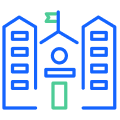Cybersecurity for schools: Everything you need to know
Data breaches in schools are becoming more common, but thankfully, we’re getting better at stopping them. Every year K-12 and higher education institutions face threats that have compromised over 6.7 million personal records and cost an estimated $53 billion in downtime.
As technology becomes a bigger part of our classrooms and administrative offices, the risks for cyber attacks increases; however, our ability to mitigate these risks and protect our schools is also growing.
By adopting strong cybersecurity measures, we can protect what matters most and make sure that our learning environments are safe and sound.
In this article, we will explore key strategies for fortifying your institution’s digital defenses, protecting it from cyber threats, and ensuring that educational processes remain uninterrupted. By embracing these approaches, educational leaders can enhance the security and resilience of their learning environments.
| Key Takeaways |
| Cyber attacks in schools are escalating in frequency and severity due to increased use of technology, affecting millions of personal records and costing billions in downtime. Schools face diverse challenges like managing a variety of tech skills among users, securing multiple devices and access points, implementing complex password management systems, proactively managing vendors, developing recovery plans, and getting their school community on board with security best practices. It’s essential for schools to implement tailored cybersecurity strategies that address their unique vulnerabilities and challenges. |
The importance of cybersecurity for schools
With K-12 schools integrating more technology into their daily operations—from classroom activities to administrative processes—safeguarding these systems against cyber threats is not just a necessity but a foundational aspect of creating a secure and effective learning environment.
In the past year, cyber attacks on educational institutions have risen significantly. A recent survey found that 80% of school IT professionals reported experiencing ransomware attacks (up 56% from the previous year). But why is this?
Schools manage a vast array of sensitive personal data, including dates of birth, social security numbers, and medical records. This makes them prime targets for cybercriminals. If this data falls into the wrong hands, it can be used for identity theft, blackmail, and harassment. On top of that, the digital expansion in education has exposed students to increased online risks, such as cyberbullying and privacy violations.
Without robust cybersecurity in educational settings, schools leave themselves open to disruptions that compromise the privacy and safety of students, staff, and faculty. That’s why many schools are taking steps to improve their cybersecurity and protect themselves against unauthorized access, data breaches, service disruptions, and other cyber threats.
Cybersecurity challenges in K-12 schools
Here are some of the primary cybersecurity challenges that K-12 schools face today:
- Diverse tech skills across users: Schools cater to a wide demographic, from young students just starting their educational journey to seasoned teachers, each with their own varying abilities and understanding of how to navigate differing technical systems.
- Multiple devices and access points: With a range of devices, from desktops and Chromebooks to iPads and personal devices via bring-your-own-device (BYOD) programs, each school faces the challenge of securing a complex array of access points. Differentiating access between guardians, students, and staff also adds another layer to this challenge.
- Poor password hygiene: Managing passwords effectively is essential to maintain network security. Schools must navigate issues like the use of weak, guessable passwords, use of the same password on multiple applications, and the challenge of getting users to change passwords after an appropriate amount of time.
- Account takeovers: Insufficient protection for accounts can lead to cybercriminals or internal bad actors gaining unauthorized access to internal accounts, resulting in potentially severe consequences such as harassment or cyberbullying and even ransomware or data theft. Robust access controls and identity verification processes are necessary to mitigate these risks.
- Managing numerous edtech tools: Schools use a diverse array of educational technology tools and applications that may contain student or staff data, each requiring secure integration and careful management to prevent vulnerabilities and protect sensitive data.
- Limited cybersecurity resources: Often, schools do not have enough dedicated IT personnel to focus on cybersecurity, which can delay response times and proactive measures.
- Ensuring unhindered learning: Cybersecurity measures should not hinder educational processes. It’s crucial that these protections are designed to support and enhance the learning environment rather than distract from the true goal of education.
Essential strategies to defend against cybersecurity threats
While the specific strategies detailed below are crucial, it’s essential to understand that a one-size-fits-all approach does not work for cybersecurity. Each school district may require customized approaches to effectively address its unique challenges. However, there are fundamental security measures, such as secure access and effective identity management, that every educational institution should implement to enhance its security posture.
At Clever, we advocate for a layered approach to security—combining multiple tools, processes, and training efforts to comprehensively cover the attack surface. This layered approach ensures that even if one defense line is breached, others are in place to mitigate the impact, providing a robust defense against a wide range of cyber threats. Below, we outline five high-level recommendations that serve as the foundation for building a secure educational environment.
1. Secure identities and access
With so many end users within a school system, the first step is to implement secure identity and access management. This prevents unauthorized access to school systems and data. Schools can enhance their security posture by:
- Implementing SSO for centralized user management.
- Using complex passphrases and MFA.
- Ensuring unused accounts are removed.
- Limiting privileged access.
At Clever, we support schools by providing tools such as Clever SSO, Clever Identity Management (IDM), and Classroom MFA, which help streamline these processes in an integrated and user-friendly way.

2. Protect devices
The next fundamental step is ensuring that all devices used within the school are secured, whether it’s a desktop, Chromebook, or tablet. This is crucial for preventing access through compromised hardware. In fact, many cyber attacks succeed because they exploit known security vulnerabilities in outdated software.
To mitigate these cybersecurity risks and strengthen their defenses, schools can:
- Secure login processes to devices.
- Apply robust endpoint protection.
- Regularly update software to close security loopholes.
Sometimes these processes are difficult—especially for younger students; however, there are tools, like Clever Badges, that help them to log in securely without having to remember complex passwords.

3. Proactively manage vendors
School districts leverage various kinds of technology to enhance student learning. Proactive vendor management allows schools to maintain system integrity, safeguard sensitive information, and ensure that third-party services align with their security standards.
To make this process more streamlined, schools can:
- Create and maintain an up-to-date list of active vendors.
- Establish a robust process to document, vet, and onboard new technology partners.
- Choose edtech vendors that prioritize cybersecurity.
4. Plan for recovery
School leaders plan for all kinds of emergencies—and cyber safety should be no different. While no one ever wants to experience a cyber attack, preparing for potential cyber incidents ensures that schools can respond swiftly and effectively, minimizing educational disruption.
Here are some things you can do to improve your cybersecurity recovery plan:
- Develop and regularly test incident response plans.
- Identify and ensure that all critical data is regularly backed up and secure.
- Maintain separated and protected environments to limit the spread of any breach.
5. Cultivate a security culture
Finally, building a culture of security is crucial to sustaining long-term defense against cyber threats. Schools need to empower every member of their community with the knowledge and tools to protect themselves and the institution.
Here’s how schools can foster this environment:
- Conduct regular training sessions to elevate cybersecurity awareness among students, staff, and administrators.
- Share updates on the latest threats, vulnerabilities, and cybersecurity best practices.
Clever extends this support through resources like Clever Academy, which offers targeted cybersecurity training for teachers and administrators designed to reinforce a vigilant and informed community.

How Clever can support your school’s cybersecurity efforts
At Clever, we are deeply committed to enhancing cybersecurity in schools, which is why we designed a comprehensive educational technology platform to simplify and secure digital learning. Our mission is to connect every student to a world of learning with technology that works everywhere. We understand the financial constraints that schools often face, which is why Clever offers a free solution for basic needs and cost-effective cybersecurity enhancements such as:
- Clever Single Sign-On (SSO) to centralize access control and reduce security breaches.
- Clever Identity Management (IDM) to secure user identities and ensure compliance.
- Classroom MFA to add an extra layer of security (ideal for devices like Chromebooks).
- Clever Badges to eliminate passwords and simplify login for young students.
- District Dashboard and Secure Sync Rostering to help manage third-party applications securely.
- Clever Academy for targeted cybersecurity training for educators.
Each tool was specifically designed to address the varying cybersecurity challenges that schools face today. Our platform is built with the security of staff and sensitive student data as a top priority.
To discover how Clever can help strengthen your school’s cybersecurity infrastructure, book a call with a Clever cybersecurity specialist, or, to get started right away, you can sign up here.

More to read

December 23, 2025
End password chaos: The 5-step guide to secure, age-appropriate logins in schoolsSchool IT departments — take these 5 steps to offload the burden of manual password resets while improving cybersecurity for classrooms.
December 10, 2025
Wonde vs. Clever: 2025 Side-by-Side ComparisonWhen it comes to choosing the right edtech platform for your school or trust, there’s a lot to consider. Can it sync reliably with your Management Information System (MIS)? Support secure logins for every user, on every device? Scale across multiple schools without overloading your IT team? Wonde and Clever are two of the most […]

October 21, 2025
Stop the Sticky Notes: Bend-La Pine’s Simple, Secure Fix for Substitute Teacher AccessRobbie Faith, an instructional technology coach at Bend-La Pine Schools, successfully implemented a Clever feature to streamline secure access to digital resources for short-term substitutes, leading to more effective sub planning for teachers, increased confidence for subs, and more consistent learning for students.


















